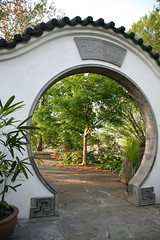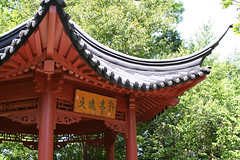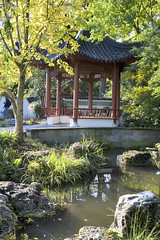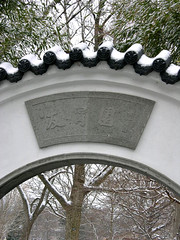The Margaret Grigg Nanjing Friendship Garden

The Margaret Grigg Nanjing Friendship Garden at the Missouri Botanical Garden is modeled on the “scholar’s gardens” of the southern provinces of China, near Nanjing, which are smaller and less ornate than the Imperial gardens of the north. Designed by Chinese-born architect Yong Pan, this garden is a showplace of extraordinary craftsmanship.
It is often said that a Chinese garden is built, not planted. The architectural elements were designed and built by Chinese artisans in Nanjing, China using the traditional colors indicative of a southern Chinese Garden: black, white, gray and reddish brown for the different elements such as the walls, pavilion, bridges, and blue stone pavings with their exquisite mosaic designs. The pavilion, marble bridge and marble balustrade were painstakingly reconstructed at the Missouri Botanical Garden during the summer of 1996, under the watchful eye of five experts from the Nanjing Municipal Bureau of Urban Parks and Open Space Administration. The Garden commemorates the longstanding scientific and cultural exchanges between the Missouri Botanical Garden and Chinese botanical institutions, and honors the sister city relationship between St. Louis, Mo. and Nanjing, China.
 Many Chinese pavilions are noted for their elaborate and fanciful carvings of animals, dragons, and sea monsters, but a “scholar’s garden” pavilion serves not only as a retreat where one can study in solitude, but as a place for delightful social gatherings, often featuring poetry contests. Its massive ceramic tile roof with its dramatic swooping shape and “smiling curves” seem to echo the upward sweep of tree branches behind the pavilion. The intricate artistry and exquisite detail of the pavilion, the focal point of the garden, creates a subtle elegance in the landscape.
Many Chinese pavilions are noted for their elaborate and fanciful carvings of animals, dragons, and sea monsters, but a “scholar’s garden” pavilion serves not only as a retreat where one can study in solitude, but as a place for delightful social gatherings, often featuring poetry contests. Its massive ceramic tile roof with its dramatic swooping shape and “smiling curves” seem to echo the upward sweep of tree branches behind the pavilion. The intricate artistry and exquisite detail of the pavilion, the focal point of the garden, creates a subtle elegance in the landscape.
The Chinese term for landscape is shan shui, literally “mountains and water.” Water is the yin, the calm, nurturing, yielding element; mountains are the complementary yang, vertical and powerful. The garden is completed with a body of water, its spiritual heart, and monumental T’ai Hu stones, from the Tai Hu region of China and other nearby regions. These fantastically shaped boulders of eroded limestone serve as nature’s statuary, evoking the awe of ancient mountains, seeming at once solid and transparent, suggesting faces, animals or spiritual forces.
 In the Nanjing Friendship Garden a hand-carved white marble bridge with a moon arch beneath traverses a narrow mountain stream that cascades over several small falls, feeding into the central pond at the heart of the garden. The hand carved white marble balustrade sits across the pond complementing the bridge. Five stones are strategically placed in the pond, symbolizing the five sacred mountains in China, while rocks from both China and Missouri have been selected for placement at the stream and water’s edge.
In the Nanjing Friendship Garden a hand-carved white marble bridge with a moon arch beneath traverses a narrow mountain stream that cascades over several small falls, feeding into the central pond at the heart of the garden. The hand carved white marble balustrade sits across the pond complementing the bridge. Five stones are strategically placed in the pond, symbolizing the five sacred mountains in China, while rocks from both China and Missouri have been selected for placement at the stream and water’s edge.
The garden’s surrounding walls have a “dragon ripple” configuration with inset ornate windows. These windows are the “eyes” of the garden allowing the visitor to look out upon a grove of bamboo just beyond the southern wall. The designer of the garden has carefully chosen traditional plantings, many of which have spiritual significance or value in Chinese culture. Plantings include pines, bamboos, willows, plum trees, forsythia, hibiscus, wisteria, peonies, lotuses, rhododendrons and azaleas, with gardenias, citrus and pen-jing in containers. Many of these plants originated in China, which has the world’s largest temperate flora. A number of them were grown from seed collected in China.
 A garden without an inscription would be as unthinkable as a Chinese painting without its rows of calligraphy in one corner. On the wall beside the handsome exit, Pendulous Lotus Gate, is a stone tablet with calligraphy of an ancient Chinese poem by Wang Wei (699-759 A.D.) inscribed around 1900 by Pu Jie, brother of the last Chinese emperor, Pu Yi:
A garden without an inscription would be as unthinkable as a Chinese painting without its rows of calligraphy in one corner. On the wall beside the handsome exit, Pendulous Lotus Gate, is a stone tablet with calligraphy of an ancient Chinese poem by Wang Wei (699-759 A.D.) inscribed around 1900 by Pu Jie, brother of the last Chinese emperor, Pu Yi:
“Sitting alone in a secluded bamboo grove,
I was singing while playing the qin,
Before realizing, in the deep grove,
The moon had already joined me
With her beautiful light.”
Editor's Note: Information on Chinese gardens was researched from The Chinese Garden: History, Art & Architecture by Maggie Keswick, London: Academy Editions, 1978, 1986. New York: St. Martin’s Press, 1986; Juliana Yuan, lecturer in Asian Art at Univ. of Missouri - St. Louis, and Joanne Fogarty.